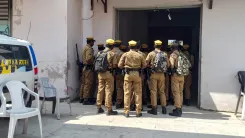Is Union Home Secretary Reviewing Security for Amarnath Yatra?

Synopsis
Key Takeaways
- Union Home Secretary Govind Mohan is reviewing security for the Amarnath Yatra.
- The yatra will run from July 3 to August 9.
- A multi-tiered security arrangement is in place.
- RFID tracking and health camps are established for pilgrims.
- Authorities are ensuring a coordinated approach to security.
Srinagar, June 17 (NationPress) Union Home Secretary Govind Mohan has arrived in Srinagar on Tuesday to assess the security readiness for the forthcoming Amarnath Yatra, commencing on July 3.
Officials indicated that the Union Home Secretary will evaluate the security measures in place for the Amarnath Yatra and examine the current security landscape in Jammu and Kashmir.
He is convening a review session at the Sher-e-Kashmir International Convention Centre (SKICC) in Srinagar.
Attending the meeting are J&K Chief Secretary Atal Dulloo, DGP Nalin Prabhat, GoC of the Army’s Srinagar headquartered 15 Corps, Lt General Prashant Srivastava, ADG (CID) Nitish Kumar, along with senior officials from CAPFs and other intelligence agencies.
This year, the annual Amarnath Yatra to the revered cave shrine, located at an altitude of 3,888 meters above sea level, will extend over 52 days, from July 3 to August 9.
Pilgrims can access the cave shrine via either the traditional, longer Pahalgam route or the shorter Baltal route. Those taking the Pahalgam route in Anantnag district reach the shrine after three days, while those opting for the Baltal route in Ganderbal district can return to base camp the same day after the ‘darshan’ inside the shrine.
The shrine contains an ice stalagmite structure that changes with the lunar phases, which devotees believe symbolizes the mystical powers of Lord Shiva.
This year's Amarnath Yatra occurs in the wake of the Pahalgam terror attack, prompting authorities to heighten security measures for the pilgrimage.
A comprehensive security framework, manned by the Army, CAPFs, and J&K Police, is already established at the shrine, base camps, and transit locations, including the route commencing from Bhagwati Nagar Yatri Niwas in Jammu, for escorted convoys transporting pilgrims to Baltal and Pahalgam.
Authorities have implemented a range of measures, including RFID tracking for yatris, real-time weather alerts, emergency evacuation protocols, and dedicated health camps to ensure the seamless execution of the yatra. RFID (Radio Frequency Identification) technology utilizes radio waves for tracking tags attached to objects.
Officials confirmed that every aspect, including detailed security protocols, has been meticulously addressed, with a cohesive collaboration between the Army, CAPFs, and local police, functioning like a well-oiled machine to guarantee comprehensive security.






